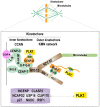Recent Progress on the Localization of PLK1 to the Kinetochore and Its Role in Mitosis
- PMID: 35563642
- PMCID: PMC9102930
- DOI: 10.3390/ijms23095252
Recent Progress on the Localization of PLK1 to the Kinetochore and Its Role in Mitosis
Abstract
The accurate distribution of the replicated genome during cell division is essential for cell survival and healthy organismal development. Errors in this process have catastrophic consequences, such as birth defects and aneuploidy, a hallmark of cancer cells. PLK1 is one of the master kinases in mitosis and has multiple functions, including mitotic entry, chromosome segregation, spindle assembly checkpoint, and cytokinesis. To dissect the role of PLK1 in mitosis, it is important to understand how PLK1 localizes in the specific region in cells. PLK1 localizes at the kinetochore and is essential in spindle assembly checkpoint and chromosome segregation. However, how PLK1 localizes at the kinetochore remains elusive. Here, we review the recent literature on the kinetochore recruitment mechanisms of PLK1 and its roles in spindle assembly checkpoint and attachment between kinetochores and spindle microtubules. Together, this review provides an overview of how the local distribution of PLK1 could regulate major pathways in mitosis.
Keywords: PLK1 kinase; PP1; PP2A; cell cycle; chromosome segregation; kinetochore; spindle assembly checkpoint.
Conflict of interest statement
The author declares no conflict of interest.
Figures



Similar articles
-
PLK1 phosphorylation of ZW10 guides accurate chromosome segregation in mitosis.J Mol Cell Biol. 2024 Jul 29;16(2):mjae008. doi: 10.1093/jmcb/mjae008. J Mol Cell Biol. 2024. PMID: 38402459 Free PMC article.
-
Spatiotemporal dynamics of Aurora B-PLK1-MCAK signaling axis orchestrates kinetochore bi-orientation and faithful chromosome segregation.Sci Rep. 2015 Jul 24;5:12204. doi: 10.1038/srep12204. Sci Rep. 2015. PMID: 26206521 Free PMC article.
-
Ubiquitylation-dependent localization of PLK1 in mitosis.Nat Cell Biol. 2013 Apr;15(4):430-9. doi: 10.1038/ncb2695. Epub 2013 Mar 3. Nat Cell Biol. 2013. PMID: 23455478 Free PMC article.
-
Orchestration of the spindle assembly checkpoint by CDK1-cyclin B1.FEBS Lett. 2019 Oct;593(20):2889-2907. doi: 10.1002/1873-3468.13591. Epub 2019 Sep 13. FEBS Lett. 2019. PMID: 31469407 Review.
-
Bub1 and BubR1: at the interface between chromosome attachment and the spindle checkpoint.Mol Cell Biol. 2011 Aug;31(15):3085-93. doi: 10.1128/MCB.05326-11. Epub 2011 May 31. Mol Cell Biol. 2011. PMID: 21628528 Free PMC article. Review.
Cited by
-
CCDC69 maintains genome integrity by regulating KIF2C/MCAK depolymerase activity and the stability of the chromosomal passenger complex.Sci Rep. 2024 Dec 5;14(1):30401. doi: 10.1038/s41598-024-81022-9. Sci Rep. 2024. PMID: 39638803 Free PMC article.
-
DNA damage checkpoint execution and the rules of its disengagement.Front Cell Dev Biol. 2022 Oct 6;10:1020643. doi: 10.3389/fcell.2022.1020643. eCollection 2022. Front Cell Dev Biol. 2022. PMID: 36274841 Free PMC article. Review.
-
PLK1 in cancer therapy: a comprehensive review of immunomodulatory mechanisms and therapeutic opportunities.Front Immunol. 2025 Jun 19;16:1602752. doi: 10.3389/fimmu.2025.1602752. eCollection 2025. Front Immunol. 2025. PMID: 40612941 Free PMC article. Review.
-
Analysis of Modular Hub Genes and Therapeutic Targets across Stages of Non-Small Cell Lung Cancer Transcriptome.Genes (Basel). 2024 Sep 25;15(10):1248. doi: 10.3390/genes15101248. Genes (Basel). 2024. PMID: 39457373 Free PMC article.
-
The application of proteomics and phosphoproteomics to reveal the molecular mechanism of salidroside in ameliorating myocardial hypoxia.Heliyon. 2024 Apr 28;10(9):e30433. doi: 10.1016/j.heliyon.2024.e30433. eCollection 2024 May 15. Heliyon. 2024. PMID: 38737233 Free PMC article.
References
Publication types
MeSH terms
Substances
Grants and funding
LinkOut - more resources
Full Text Sources
Miscellaneous

